"Going to The Boat!" 1967
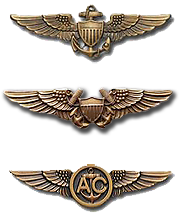
A P-3 Pilot Remembers
“Going to The Boat!”
By: CAPT Randy Hotton, USN (Ret.)
Back in the 60s, when I went through flight training, all student naval aviators had to “Carrier Qualify” (CARQUAL or CQ). When I “went to the boat” solo, in August 1967, in the big, loud, dirty T-28C, I had 142.2 hours total time and 116.8 in the T-28. The carrier work up was about three weeks of doing daily FCLP’s (Field Carrier Landing Practice) until we had 75 passes.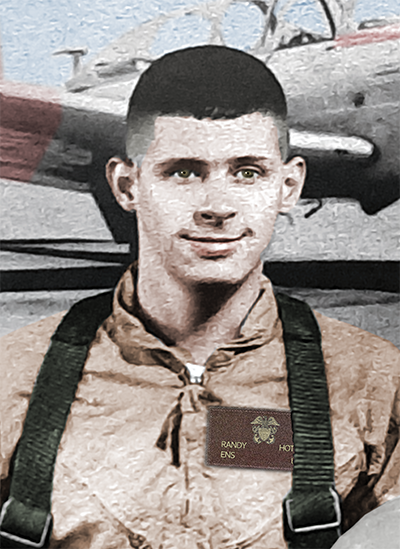
Then we stood by in the squadron ready room waiting for our launch. My flight waited three days for the call to go; however we did one FCLP flight on the second day of waiting to maintain currency. The T-28 could deck launch without the catapult so they were on a loose schedule around the jet CQ schedule. (Photo to right: ENS Randy Hotton)
Then it was launch a four plane formation flight, transit to the boat and wait for your call to go into the break. After that you just follow the instructions you were taught like fly 325 feet 82 Kts, put the tip of the star on the left wing down the center of the aircraft carrier deck, when the boat disappears, make 20 degree left bank until the boat is in front of you. Then you should see the ball on the mirror, make ball call and start playing the meatball, line up, airspeed game.
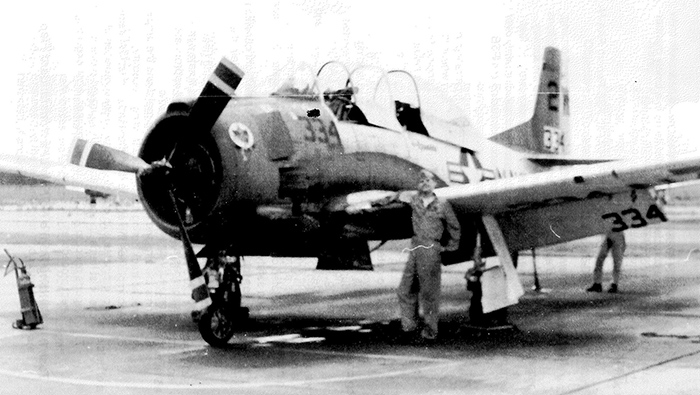
You just looked out the window, kept the meatball in the center with power, worked hard to stay on centerline and worked airspeed with nose attitude. You never looked at the ship or the landing area because it was moving away from you and would create an optical illusion. The visual glideslope varied with the speed of the ship through the water to make 25 knots across the deck. You did not flare; when the cut lights came on, you just cut the power and flew into the ship and, hopefully, caught a wire. Our approach speed was 82Kts, so with 25Kts of wind across the deck the closure rate was not all that great...say, about 60Kts. (Photo left: Breathing easy after CQ)
The training protocol called for two touch-and-goes followed by six arrested landing and deck launches. All done that day on an old WWII aircraft carrier named USS Randolph...with a very small deck.
For each launch off the boat, we were pointed toward the starboard bow, and told when the end of the ship disappeared in front of you, you pulled the stick back as far as you could, it will fly! Do not look at the airspeed indicator, it will not be reading anything that made sense. They were right I looked at it, it was below 50 Kts Indicated.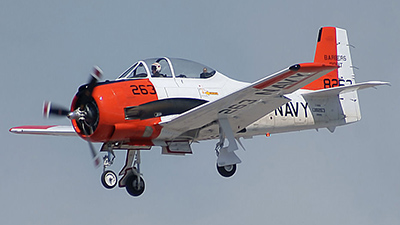
We were briefed that if you crossed the center line of the ship on take off it was an automatic down (failure), because of possible interference with the bolter pattern. So, not wanting to get a down, I unlocked my shoulder harness and looked over my left shoulder to make sure I was still on the starboard side of the center line...I was. Then, coming back around in the pattern, it was my turn to break; and I had forgot to reset my shoulder harness. So, on my second trapped landing, my shoulder harness was still unlocked. BAMMM!! My right shoulder and my head slammed into the glare shield, thank goodness for helmets. My left hand went full forward on the power, somewhat in a WTF moment. Bringing myself back to my senses, I saw the launch officer shaking his fist at me and pointing toward the starboard bow, wanting to keep things moving. No one knew about my screw-up except me. Locking the harness, off I go again. (Photo above left: T-28...not a small aircraft!)
It was one of the high points of my life; I knew that by completing this, I would now make it through training and be designated a Naval Aviator. What a fantastic adventure.
In advanced training, I had to CARQUAL again - however, this time, in the TS-2A on the USS Lexington. But this CQ wasn’t near as big a deal since I already had orders to a P-3 squadron (VP-45). However the training did come in handy when later, as ship’s company, I got to fly the C-1A (COD) off of the USS Enterprise. Now that was a big boat compared to the ones we landed on in training. Heck, a “Taxi One Wire” grade was very easy to get.
Younger guys all flew those modern Jet A burning T-34’s; we old timers flew the 100 octane AvGas powered B models. Even then, at VT-1, you knew why it was nick-named the “Teeny Weenie”.
At Saufley Field in VT-1, we were hangared next to VT-5 and their T-28Cs, the carrier qualification birds. We flew the T-34 with no radio communication, but the T-28’s got to talk to the tower. When the T-28’s were taxiing, all T-34s had to stop, yield and let them pass. They ruled the field. 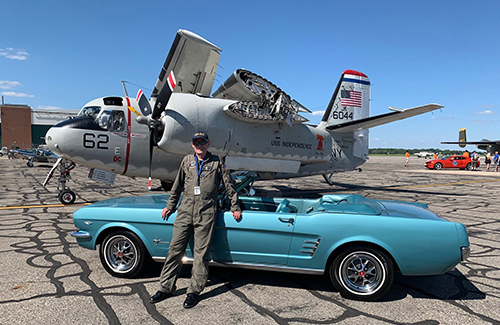
An idling T-28 R-1820 radial engine sounds mean, powerful, and macho. They would rumble by you in your idling T-34’s IO-470 engine that sounded like a kitten purring. You had to look up to these birds when they passed and you saw the older oil and grease stained flight suits on these T-28 student pilots...who even looked older. Then you looked at your fresh off-the-rack spotless flight suit and truly knew you were a rookie in this flying business. But six months later, you would be back to Saufley in your now dirty flight suit taxiing those same VT-5 T-28’s with the tail hooks feeling quite salty and superior; and you knew exactly what the T-34 pilots were thinking.
Submitted by: Randy Hotton, a pilot assigned to VP-45 1968-1971. He is pictured to the right in 2020.
Send questions, comments or suggestions regarding this website to: vp45assoc@vp45association.org
Copyright © 2005 PATRON FOUR FIVE ASSOCIATION


